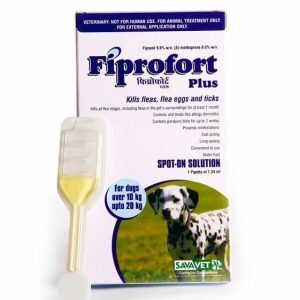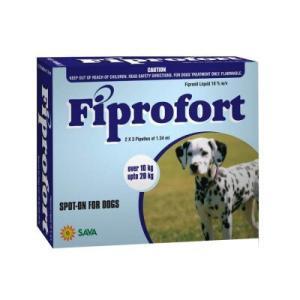Table of Contents
Fiprofort Plus Dog is a dog-specific product related to flea and tick control. Effective flea and tick control products for dogs contain an active ingredient called Fipronil, which effectively eliminates and prevents infestations.

What Is Fiprofort Plus for Dog?
Fiprofort Plus for Dogs provides convenient and effective flea and tick control for dogs and puppies over 8 weeks of age. It protects up to 6 months against fleas and 3 months against ticks, depending on the level of environmental challenge.
Fipronil + Methoprene is a combination of active ingredients used in products for dogs and cats. Fipronil is an insecticide that targets adult fleas and ticks. And what is the Methoprene mode of action? Methoprene is an insect growth regulator (IGR) that prevents the development of flea eggs and larvae.
Fipronil + Methoprene products provide comprehensive protection against fleas and ticks at various life stages when used together. Fipronil eliminates adult fleas and ticks by affecting their nervous system, while Methoprene disrupts the growth and development of flea eggs and larvae, preventing them from maturing into adults.
Ingredients
Each pipette contains the following:
- Fipronil – 9.8% w/v
- (S)-Methoprene – 8.8%
- Excipients q.s.
Forms of the Medicine
Fipronil + Methoprene is commonly available in spot-on formulations for dogs. There are no sprays, granules, or oral medicines with Fipronil and Methoprene for dogs.
To determine the available forms of Fipronil + Methoprene for dogs, check with a veterinarian or contact pet supply stores or manufacturers directly. They will be able to provide you with the most up-to-date information on the specific products and formulations available in your area. Additionally, they can offer guidance on selecting the most suitable flea and tick control for your dog based on their individual needs and preferences.
Uses of Fiprofort Plus for Dogs
What is Methoprene used for?
This spray for dogs is typically used to control and prevent fleas and ticks. Here are some situations when Fipronil and Methoprene uses:
- If your dog has a flea or tick infestation, using a Fipronil + Methoprene spray can help eliminate the existing parasites and prevent further infestations.
- Even if your dog doesn’t have fleas or ticks, a preventive spray can help keep them protected against these pests. Regular application can help prevent infestations and ensure your dog is free from fleas and ticks’ discomfort and potential health risks.
- Fleas and ticks are more prevalent during certain seasons, so using a Fipronil + Methoprene flea spray can be particularly beneficial. This helps to protect your dog from potential infestations proactively.
- If your dog spends a lot of time outdoors, especially in areas where fleas and ticks are common, spraying can provide an extra layer of protection. It helps repel and kill these parasites before attaching them to your dog’s coat.
Who Can Take the Medicine?
It’s always best to consult a veterinarian for recommendations on safe and effective flea and tick control products. They can guide you in selecting the appropriate product for your pet’s specific needs and provide instructions on proper application or administration.
Fiprofort Plus for Dogs
Fiprofort Plus for Dogs is a specific product containing Fipronil + Methoprene, formulated specifically for dogs. Therefore, it should only be used on dogs and not be administered to other animals, including cats.
Medication for Cats
If you are looking for a flea and tick control product for cats, choosing a product specifically labeled for use in cats is essential. Cats are more sensitive to certain compounds and can react adversely to products formulated for dogs. Using a dog-specific product on cats can be dangerous and potentially harmful to their health.

Dosage Sizes
| Weight Category | Dose | Fiprofort Plus Dosage (ml/pipette) |
|---|---|---|
| Small Dogs (for use on puppies from 8 weeks of age) | Up to 10 kg | 0.67 |
| Medium Dogs | 10 – 20 kg | 1.34 |
| Large Dogs | 20 – 40 kg | 2.68 |
| Extra-large Dogs | Over 40 kg | 4.02 |
How to Use Spray
These products typically come in spot-on formulations, where a small amount of liquid is applied to the dog’s skin, usually between the shoulder blades or along the back. The active ingredients are distributed through the dog’s natural oils, providing long-lasting protection against fleas and ticks.
Following the instructions is essential when using a Fipronil + Methoprene spray for dogs. Here is a general overview of how to apply flea treatment to dogs:
- Carefully read and understand the instructions, warnings, and precautions provided with the product. Follow them precisely to ensure effective and safe use.
- Ensure the spray is specifically formulated for dogs and labeled for their weight and age. Using products intended for other animals or species may be unsafe or ineffective.
- Select a well-ventilated area for application. Do it outdoors or in a well-ventilated room to avoid inhaling the spray.
- Wear protective gloves to prevent any skin contact with the product. Avoid touching your face or eyes while applying the spray.
- Hold the spray bottle upright and apply the product evenly onto your dog’s coat. Start at the back of the neck or between the shoulder blades and work down the body, parting the fur if necessary. Be sure to cover the entire body, including hard-to-reach areas like the belly and armpits.
- Use the recommended amount of spray based on your dog’s weight, as indicated on the product label. Avoid over-saturating the coat, but ensure that the product reaches the skin.
- Avoid spraying the product directly into your dog’s eyes, ears, mouth, or genitals. If necessary, you can use a cloth or sponge to apply the spray to the head area, being cautious around the sensitive areas.
- Allow the product to dry naturally on your dog’s coat. Avoid touching or grooming your dog until the spray is completely dry to prevent product transfer or ingestion.
- Follow reapplication instructions: Note the recommended reapplication interval provided by the product. Some sprays provide long-lasting protection, while others may require more frequent application.
Important Safety Information for Owners
When using this product, knowing important Fipronil and Methoprene safety information is crucial.
Take care to avoid direct contact of the spray with your dog’s eyes, mouth, or ears. If accidental contact occurs, rinse thoroughly with clean water. Use the recommended amount of spray based on your dog’s weight, as indicated on the product label. Avoid under-dosing or overdosing, as this may affect the product’s effectiveness or lead to adverse reactions. Store the product out of reach of children and other pets to prevent accidental ingestion or contact. Keep the product in a secure place when not in use. After applying the spray, observe your dog for any signs of adverse reactions such as excessive salivation, vomiting, diarrhea, lethargy, or skin irritation. If any unusual symptoms occur, contact your veterinarian immediately. Avoid spraying sick, pregnant, or nursing dogs unless specifically instructed by a veterinarian. It’s essential to consult a veterinarian before combining the spray with other topical or oral medications to avoid potential interactions or adverse effects.
Veterinary Prescription
The need for a veterinary prescription to purchase a Fiprofort Plus spray for dogs can vary depending on the country. Certain flea and tick control products in some regions, including those containing Fipronil + Methoprene, may require a prescription from a veterinarian. These products are often called “prescription-only” or “veterinary-exclusive” products.
However, flea and tick control products that do not require a prescription are available over the counter (OTC). They can be purchased directly from pet supply stores, online retailers, or pharmacies without a prescription.
Contraindications
Fiprofort Plus spray for dogs may have contraindications:
- Dogs with known hypersensitivity or allergy to Fipronil, Methoprene, or any other ingredients in the spray should not use the product.
- Some Fipronil + Methoprene sprays may have age and weight restrictions. Ensure you select a product suitable for your dog’s age and weight range, as the product label specifies.
- Dogs with certain underlying health conditions may have contraindications to Fipronil + Methoprene spray. These conditions could include liver disease, kidney disease, or other systemic illnesses. It’s essential to consult a veterinarian to determine if the spray is safe for dogs with specific health conditions.
- Some products may have contraindications for pregnant or nursing dogs. Following the product instructions and consulting a veterinarian for spray use during these stages is crucial.
- There may be potential contraindications or interactions between Fipronil + Methoprene spray and other medications your dog may be taking. Inform your veterinarian about the medications your dog is receiving to ensure compatibility and safety.
- Fipronil + Methoprene spray formulated for dogs should not be used on cats or other animals unless specifically indicated by the manufacturer.
Side Effects
Fiprofort Plus spray for dogs can cause side effects. While most dogs tolerate these products well, adverse reactions are possible. Monitor your dog after application and be aware of any unusual symptoms. Here are some potential side effects of Fipronil and Methoprene sprays:
- Some dogs may experience mild skin irritation or redness at the application site. This can include itching, swelling, or a rash. If skin irritation persists or worsens, discontinue use and consult with a veterinarian.
- In some cases, dogs may experience gastrointestinal upset, such as vomiting or diarrhea, after exposure to the spray. If these symptoms persist or worsen, seek veterinary advice.
- While rare, some dogs may exhibit neurological symptoms such as tremors, unsteady gait, or lethargy. If you notice abnormal behavior or neurological signs, discontinue use and seek immediate veterinary care.
- Dogs with known hypersensitivity or allergy to Fipronil, Methoprene, or any other ingredients in the spray may experience allergic reactions. These reactions can range from mild itching and swelling to severe reactions, including difficulty breathing or collapse. If your dog shows an allergic reaction, seek immediate veterinary attention.
- In rare cases, dogs may experience systemic effects from the absorption of Fipronil or Methoprene into their bloodstream. These effects can include changes in appetite, behavior, or lethargy. If you observe any concerning systemic symptoms, consult with a veterinarian.
These side effects are not exhaustive, and individual dogs may react differently. If you observe any unusual or concerning symptoms after using this medicine, it’s recommended to discontinue use and consult with a veterinarian.
Overdose
An overdose of Fiprofort Plus spray for dogs can lead to adverse effects. If an accidental overdose occurs, you should take the following steps:
- Contact a veterinarian: If you suspect your dog has been exposed to an overdose of Fipronil + Methoprene spray, contact your veterinarian immediately.
- Provide information: Inform the veterinarian about the specific product used, the approximate amount applied, and your dog’s weight. This information will help the veterinarian assess the potential risks and determine the appropriate action.
- Observe your dog: While waiting for veterinary advice, monitor your dog closely for any signs of adverse effects or unusual symptoms. These may include excessive salivation, vomiting, diarrhea, tremors, unsteady gait, or other abnormal behavior. Note down any observed symptoms to share with the veterinarian.
- Follow veterinary instructions: The veterinarian may provide instructions over the phone or recommend bringing your dog in for an examination. Follow their guidance closely and adhere to any treatment recommendations or monitoring procedures they suggest.
It’s important to remember that an overdose of spray is not expected when used according to the recommended dosage. However, if you have any concerns or suspect an overdose, seeking veterinary assistance is the best course of action to ensure your dog’s well-being.
Fiprofort Poisoning
If you suspect that your dog has Fipronil and Methoprene toxicity, it is crucial to take immediate action to ensure your dog’s safety. Here are the steps to follow:
- Remove your dog from the area: If your dog is still in contact with the spray or any contaminated surfaces, remove them from the area to prevent further exposure.
- Contact a veterinarian or a pet poison control hotline: Get in touch with a veterinarian or a pet poison control hotline as soon as possible. They can guide how to proceed and give specific instructions based on your dog’s condition.
- Provide information: When contacting the veterinarian or pet poison control, inform them about the product used, the approximate amount applied, and any observed symptoms. This information will help them assess the situation and provide appropriate advice.
- Observe your dog: Monitor your dog closely for any signs of poisoning, including excessive salivation, vomiting, diarrhea, tremors, seizures, difficulty breathing, or abnormal behavior. Note down any observed symptoms and changes in your dog’s condition.
- Follow veterinary instructions: The veterinarian or pet poison control expert will guide you on the following steps. They may instruct you to induce vomiting, administer activated charcoal, or bring your dog to a veterinary clinic for immediate treatment. Follow their instructions carefully and promptly.
- Seek veterinary care: In cases of suspected poisoning, seek veterinary care immediately. The veterinarian will thoroughly examine, provide appropriate treatment, and closely monitor your dog’s condition.
It’s important to remember that Fipronil + Methoprene spray poisoning is dangerous, and immediate veterinary attention is crucial. Time is of the essence when dealing with potential poisoning, so do not hesitate to seek professional help.
Storage
Spray should be stored in a cool, dry place away from direct sunlight and excessive heat. High temperatures can degrade the product or cause changes in its effectiveness. Store the spray in a secure location inaccessible to children and pets. Please keep the product in its original container. Do not transfer it to other containers, which may cause confusion or mislabeling. If you have unused or expired Fipronil + Methoprene spray, dispose of it according to local regulations. Contact your local waste management authority or veterinarian for guidance on the proper disposal method.
Generic and Brand Names of Fiprofort Plus
In 2023 Fipronil + Methoprene spray for dogs is available under various generic and brand names. Here are some examples:
Generic Names
- Fipronil + Methoprene Spray
- Fipronil and Methoprene Combination Spray
- Fipronil + (S)-methoprene Spray
Brand Names
- Frontline Plus Spray
- Certifect Spray
- Effitix Spray
- Fiproguard Plus Spray
- Parastar Plus Spray
Please note that the availability of specific brands and generic names may vary depending on your country or region. Check with your veterinarian or local pet supply stores to determine which specific brands or generic versions are available in your area.
Other Drugs in the Same Class
This medicine belongs to a class of drugs known as ectoparasiticides. While Fipronil + Methoprene is a specific combination, other drugs in the same class may have similar or alternative active ingredients. Here are some examples of drugs in the same class as Fipronil + Methoprene spray:
- Imidacloprid + Permethrin: This combination is used in some flea and tick control products for dogs. Imidacloprid is an insecticide that targets adult fleas, while Permethrin is an insecticide that kills and repels ticks and other pests. Besides, Methoprene is less toxic than Permethrin.
- Pyrethrin + Piperonyl butoxide: Pyrethrin is a natural insecticide derived from chrysanthemum flowers, and piperonyl butoxide is a synergist that enhances its effectiveness. This combination is found in some dog flea and tick sprays or shampoos.
- Fluralaner: Fluralaner is an active ingredient in some oral flea and ticks medications for dogs. It works by interfering with the nervous system of fleas and ticks, ultimately leading to their elimination.
- Selamectin: Selamectin is a parasiticide used in some topical formulations for dogs. It effectively treats and prevents fleas, ticks, ear mites, and other parasites.
- Spinosad: Spinosad is an ingredient used in certain oral flea medications for dogs. It is derived from a naturally occurring bacterium and is effective against fleas.
While these drugs may belong to the same class, they may have different mechanisms of action, safety profiles, and usage instructions.
Active Ingredients of the Spray Comparing to Other Medications
When comparing Fipronil + Methoprene spray to products containing imidacloprid or methoprene/pyriproxyfen, it’s important to consider the specific formulation, recommended usage instructions, and any additional active ingredients.
Fipronil vs Imidacloprid
- Fipronil: Fipronil is an insecticide that targets adult fleas and ticks. It works by interfering with the nervous system of these parasites, ultimately leading to their death. Fipronil is known for its long-lasting effects and is widely used in flea and tick control products for dogs.
- Imidacloprid: Imidacloprid is another insecticide commonly used in flea control products. It primarily targets adult fleas but may also have some effect on flea eggs. Imidacloprid works by disrupting the normal functioning of the fleas’ nervous system, resulting in their paralysis and death. It is also effective against certain other insects.
Methoprene or Pyriproxyfen Products
- Methoprene: Methoprene is an insect growth regulator (IGR) in many flea control products. It mimics the juvenile hormone in insects, preventing the development of immature flea stages (eggs, larvae, and pupae). By disrupting the normal growth and development of fleas, Methoprene helps to break the flea life cycle and prevent reinfestation.
- Pyriproxyfen: Pyriproxyfen is another insect growth regulator that works similarly to Methoprene. It also interferes with the growth and development of fleas, preventing them from reaching the reproductive adult stage. Pyriproxyfen is effective against flea eggs, larvae, and pupae, providing long-lasting control.
FAQ
Are Fipronil and Methoprene safe for dogs?
Fipronil and Methoprene are considered safe for dogs when used according to the recommended dosage and administration guidelines. However, as with any medication, individual sensitivities or allergic reactions can occur.
How long does it take for flea treatment to work?
The speed at which a flea treatment works can vary depending on the product and the severity of the infestation. Some flea treatments, such as spot-on or oral medications, can kill fleas within a few hours. However, it may take several days for the infestation to be fully controlled.
Is Methoprene safe for humans?
Methoprene is generally considered safe for dogs and cats but is not intended for use in humans. It is an insect growth regulator that targets the development of fleas and other insects. While it is considered safe when used as directed for pets, it is not designed or approved for human use. If accidental exposure or ingestion occurs in humans, seeking medical advice or contacting a poison control center is recommended. Contact your doctor according to lice treatment containing Fipronil.
Is Fipronil and Methoprene combination beneficial?
Combining these two active ingredients offers broad-spectrum protection by targeting adult fleas and ticks and disrupting the flea life cycle. Fipronil kills adult fleas and ticks, while Methoprene inhibits the development of flea eggs, larvae, and pupae. This combination can provide more comprehensive flea control and help prevent reinfestation.
Which is the best flea treatment for dogs?
The best dog flea treatment may vary depending on age, weight, health status, and known allergies or sensitivities. Commonly used dog flea treatments include spot-on treatments like Fiprofort Plus, oral medications, collars, and sprays. Your veterinarian can help determine the best option for your dog.
Where can I buy Methoprene and Fipronil for dogs?
Fipronil-based flea and tick products for dogs are commonly available at veterinary clinics, pet supply stores, and online retailers. You can check with your local veterinary clinic or pet store to see if they carry Fipronil products. Additionally, many reputable online retailers offer cheap Fipronil spray for dogs, allowing you to purchase them online conveniently. Ensure that you are purchasing from a trusted source to guarantee the authenticity and quality of the product.

































